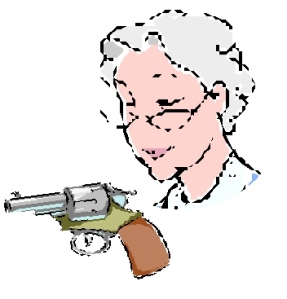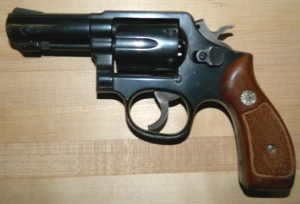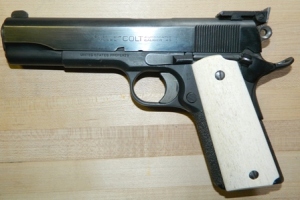 THE WHITE HAIRED SHOOTER
THE WHITE HAIRED SHOOTER
Today I am going to take a few minutes for back to basics, and discuss first what a GUN is, and what it isn’t.
A gun is: a mechanical tool, made up of a closed tube and other mechanical attachments used with a propellant to forcefully fire a projectile. It is called many things, including a firearm, pistol, weapon, and sometimes a piece, revolver or semiautomatic.
A gun isn’t: self defense, protection, or an insurance policy so that bad things won’t happen. Those are what you hope to accomplish, and there is a world of difference in possessing a tool, and having a tool you know how to use in order to reach a goal.
Brief History of Handguns
A brief look at the history of handguns takes us to China where gunpowder was first developed in the 9th century. Records show that the first “fire stick,” essentially a tube that could forcefully throw flames and occasionally shrapnel was developed by the Chinese in 1232, and further developed to propel objects by 1260. The technology spread to the Middle East, then to Europe with the development of trade routes. Many design innovations were made in the ensuing years, and development leading to modern long guns began in 1364 with the invention of the matchlock musket, and by 1400 the forerunner of the modern pistol, a matchlock gun made its appearance.
It wasn’t until 1835, in the United States, that the first revolver made its appearance – the Colt Revolver, a Single Action handgun, which was a descendent of the Pepperbox, which was a drum containing a number of barrels, each with a chambered round that rotated to bring it in line with the hammer. The year 1877 saw the advent of the first effective Double Action revolver. The first semiautomatic, also called self loading handgun was credited to Joseph Lauman in 1892, but the first semi automatic pistol with separate magazine in the grip was manufactured by Borchardt in 1893. From there the development of the modern handgun as we know it today was firmly on track and the essential mechanics have largely remained the same with variations and features being refined. Modern handguns – whether Revolver or SemiAutomatic, are comprised of three main parts: The frame, the barrel, and the “action.” They also include a trigger mechanism, that releases a hammer or striker to fire the cartridge.
Main Types of Handguns
There are many types of pistols, and this article is going to look at the more common breech loading self defense handguns: the Revolver and the SemiAutomatic. Less commonly used for modern self defense are the bolt action pistols, derringers, muzzle loaders, air guns, and so on.
 Revolvers
Revolvers
The Revolver gets its name from the rotating cylinder mounted on the frame just before the barrel. The cylinder is chambered to hold cartridges.
A Single Action (SA) revolver must have the hammer manually cocked, which rotates the cylinder, and the trigger’s only function is to release the cocked hammer so that it can strike the primer on a cartridge.
A Double Action (DA) will accomplish two tasks when the trigger is pressed: it will cock the hammer, which rotates the cylinder, and release the cocked hammer. Most Double Action revolvers can have the hammer cocked manually, and then used in Single Action.
An exception is the more modern hammerless Double Action Only (DAO) where the hammer is absent.
Cartridges are manually loaded into the cylinder, and then unloaded by means of an ejector rod. Most single action revolvers are loaded through a spring action loading gate and by rotating the cylinder manually. Most modern double action revolvers have a cylinder release that drops the cylinder to the side of the frame where it is open to be loaded. Some revolvers use a break action to load, which basically drops the cylinder and barrel down exposing the cylinder for loading.
Most revolvers do not have a mechanical safety device although some have a trigger safety that unlocks in response to the trigger being properly pulled. Some revolvers also come with an action locking mechanism for storage.
 Semi Automatics
Semi Automatics
A semi-automatic pistol has a slide that can freely move back and forth on the frame. The barrel can either move with the slide, or be firmly attached to the frame. The slide houses the firing pin and an extractor, and an ejection port on the slide is where empty shells exit the handgun after firing.
Semi-Automatics can also be Single Action or Double Action or Double Action only.
Cartridges are stored in a magazine that is inserted into the grip, and loaded from the top of the magazine one at a time into the chamber. The first round must be manually loaded on most handguns by racking the slide. There are some models that can have the first round chambered manually through a port/lift up on the barrel. Some semi automatics have an indicator that a round is chambered.
The semi automatic with a blowback operated action, most common with low-powered cartridges like .22, .25, .32 and sometimes .380, utilizes pressure built up from gasses generated by the firing of a cartridge, and with the help of a strong spring racks the slide, ejects the spent cartridge, and loads a new cartridge. A recoil-operated action is more common sometimes with a .380, and with 9mm or greater cartridges. Upon firing, the barrel and slide recoil rearward together, then the barrel unlocks and the slide travels further back to complete the cycle. Another type of action is called gas-operated, where high pressure gasses are “bled off” from the barrel through a small hole and then uses pressure to drive the slide backward.
Semi-automatics have mechanical safeties of many varieties and combinations.
And that concludes a basic introduction to the handgun.
In the next post we’ll look at the basics of ammunition. Until then,
Happy and Safe shooting – Peggy
oneweaponanytool
May 19, 2014 at 8:13 pm
A gun is also not a magic wand that you can wave around and hope to “scare away” the bad guy with. It is a tool made for a specific purpose to solve specific problems. Train with it, don’t hope with it!
whitehairedshooter
May 19, 2014 at 8:38 pm
Well said! Thank you.
Archon's Den
May 22, 2014 at 9:33 pm
Weren’t matchlocks all smoothbores – therefore, muskets, not rifles?
whitehairedshooter
May 22, 2014 at 10:04 pm
Hi! Thanks for your comment. I just rechecked my sources, and the MAJORITY of matchlocks were indeed smoothbores, but there were SOME that were rifled – which gave them more accuracy. Since the rifling appeared a bit after the initial “invention” I mentioned, I have corrected the article to remove “rifle” and reworded that sentence to read: “and development leading to modern long guns began in 1364 with the invention of the matchlock musket, and by 1400 the forerunner of the modern pistol, a matchlock gun made its appearance.”
I really appreciate you taking the time to visit and point me towards more accuracy! Thanks again.